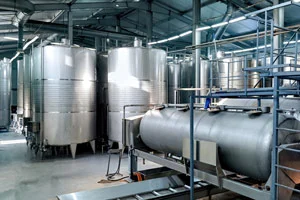Wine acidity is one of the main characteristics that should be taken care of during production. Sometimes there are factors during the harvest that can result in a batch that does not have the right quality. To try to solve this problem, various techniques are used to correct the acidity of the wine, which are regulated and duly authorized.
The role of acidity in wine
The wine has its own acidity derived from grapes, resulting from the following acids:
- Tartaric acid, from the wine itself.
- Malic acid is a rough acid from immature fruits.
- Citric acid provides fresh and aromatic flavors.
Then others are incorporated during the fermentation of the grapes:
- Succinic acid provides salty and bitter sensations in the mouth, in a very subtle way.
- Acetic acid comes from the acetic fermentation related to certain bacteria.
- Lactic acid, derived from malolactic fermentation (lactic bacteria).
As for wines, the acidity ranges from 4 to 7 g/l of tartaric, although it is preferable that it never reaches either end.
In wines, total acidity is the sum of all the acids named above, expressed as tartaric acid.
Having clarified these concepts, it must be said that a good wine must possess a good level of acidity. If there is no acidity, the batch will be low quality, resulting in a dull, heavy wine with excess sweetness.
Types of acidity: volatile acidity and fixed acidity
A wine’s total acidity is composed of fixed acidity and volatile acidity.
Fixed acidity is the set of the wine’s natural acids that we have already seen before (tartaric, malic, citric, succinic and lactic).
The most important of these is tartaric acid, hence the measurement of fixed acidity is done in grams of tartaric acid per litre.
The acids that make up the fixed acidity preserve the wine’s natural qualities, as well as its color.
The volatility of the acids in the wines is very low, which is a good sign that the wine has the quality the oenologist is seeking for its marketing.
Correcting wine acidity: techniques
From the description above, it can be deduced that if there is good acidification, the resulting wine will be balanced, with the desired color, will be pleasant to the palate and will have adequate conservation under normal conditions.
But it may be necessary to correct the acidity with certain perfectly lawful techniques, by increasing it (acidification) or reducing it (deacidification).
Techniques for correcting the natural acidity of wines:
- Adding tartaric acid can be done before, during and after fermentation. This is a very common procedure that increases the total acidity of the product.
- Incorporating citric acid, although somewhat unstable, has little influence on total acidity. An excess will result in a bitter taste of the wine.
- Using malic acid, which is also unstable, provides an aggressive and green taste to the wine.
- Lactic acid softens the wine with pleasant aromas in the form of dairy flavors.
As mentioned above, wines can be de-acidified using certain yeasts or by malolactic fermentation. In both cases, malic acid is acted upon to ensure a drop in the product’s acidity.
There are other chemical deacidification techniques:
- With calcium carbonate. It reacts with tartaric acid when added to the wine, forming neutral calcium tartrate, which precipitates to achieve lower acidity.
- Potassium bicarbonate. When added to the wine, it reacts with tartaric acid to form potassium bitartrate, which precipitates, de-acidifying the wine more effectively than calcium carbonate.
- Neutral potassium tartrate. A molecule of this compound reacts with the tartaric acid by precipitating, thereby decreasing the acidity of the wine. It is not a widely used method because it does not have a great capacity for reducing the acidity of the product.
The role of potassium in wine acidity
The Potassium ion is found in the first 60 cm of the vine layer, being absorbed by the most superficial roots of the strain. In years of normal or high rainfall, the roots do not have to deepen the search for water, so there is a greater absorption of K. Other factors, such as fertilisation, variety, rootstock or the amount of abscisic acid, will influence the final amounts of potassium in the berry, which will be distributed differently between the skin, the pulp and the seed. The K+ present in the berry is mainly found in the skin and in the scrape. This is why a very significant part of the K+ is transferred during maceration.
Red wines have higher concentrations of potassium because they are in contact with the skins, as well as those made with the carbonic maceration technique due to the contact of the rasp with the must, which can increase the amount of K by 100 mg/l. The pH of a wine will be directly related to the amount of K.
The production of musts which are lower in potassium is the basis of several practices:
– Choice of the most suitable cultivation soil. With low amounts of K and low fertilizer needs.
– Choice of varieties and rootstocks that have a low K-absorption capacity.
– Cultivation techniques (irrigation control, loading, pruning…).
– Shorter macerations.
– Soft pressing.
– Removal of cation through the Free K+ system.
Agrovin’s solutions for correcting the wine’s acidity
Agrovin provides procedures for the acidification and stabilization of wines by using cation exchange resins that do not degrade the quality of the product.

The Free K system involves:
– The elimination of potassium (K) and calcium (Ca) cations that give rise to tartaric failures.
– Eliminate iron (Fe) and copper (Cu) cations, responsible for iron and copper failures and also act as catalysts in oxidations.
– Ensure the cession of protons (H+) to increase total acidity and decrease pH.
As we have seen, acidity in musts and wines is necessary and legal protocols must be established if it is not achieved naturally.

